_Editor’s note: This multimedia series documents the mechanics of how 12 districts in Tamil Nadu worked during the COVID-19 lockdown; told through the stories of healthcare workers, sanitary workers, district officials, other essential workers, administrators, locals and patients. The series resulted from three weeks of travel through the state._
***
Pachaiyappan’s COVID Mobile Vehicle drives into the quarantine facility at Maha Barathi Engineering College in Chinna Salem. The decorated sign at the entrance reads ‘Welcome Home, District Kallakuruchi’. With him, head to toe in PPE is his colleague S Ranjani. Both of them are returning from a trip to two neighbouring villages, after accomplishing what might be crucial to isolating the imminent threat of a Covid 19 community spread. [caption id=“attachment_8469791” align=“alignnone” width=“640”] The decorated sign at the entrance reads ‘Welcome Home, District Kallakuruchi’. Firstpost/Greeshma Kuthar[/caption] As the ambulance approaches the officials gathered to receive the new entrants, Pacahaiyappan and Ranjani’s responsibilities almost come to an end. Maybe they won’t get another call, as the sun had almost set. Maybe the next batch of out-of-state returnees will only come in the next morning. Maybe they could finally take off their PPEs. Ranjani throws a weary look at the three young men exiting the ambulance. All three of them though seem to be in high spirits, sharing an inside joke as they make their way to the entrance of the quarantine facility. Two of them had just returned from Maharashtra and one from Chennai. Upon reaching Kalakuruchi, the three went to their homes instead of showing up at the quarantine facility, which is the procedure. The responsibility of bringing them to the facility was then handed over to Ranjani and Pacahiyappan. [caption id=“attachment_8469801” align=“alignnone” width=“640”]
The decorated sign at the entrance reads ‘Welcome Home, District Kallakuruchi’. Firstpost/Greeshma Kuthar[/caption] As the ambulance approaches the officials gathered to receive the new entrants, Pacahaiyappan and Ranjani’s responsibilities almost come to an end. Maybe they won’t get another call, as the sun had almost set. Maybe the next batch of out-of-state returnees will only come in the next morning. Maybe they could finally take off their PPEs. Ranjani throws a weary look at the three young men exiting the ambulance. All three of them though seem to be in high spirits, sharing an inside joke as they make their way to the entrance of the quarantine facility. Two of them had just returned from Maharashtra and one from Chennai. Upon reaching Kalakuruchi, the three went to their homes instead of showing up at the quarantine facility, which is the procedure. The responsibility of bringing them to the facility was then handed over to Ranjani and Pacahiyappan. [caption id=“attachment_8469801” align=“alignnone” width=“640”]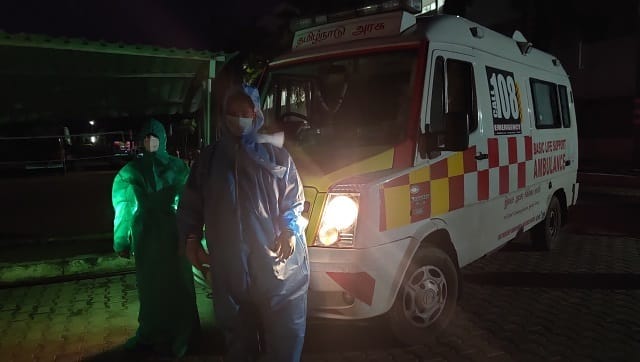 Ranjani and Pachaiyappan in front of their mobile unit. Firstpost/Greeshma Kuthar[/caption] Two of the young men had packed up and followed Ranjani when she showed up at their door. The third one, the returnee from Chennai, had been a problem. “When I informed him, he said he’ll come along. After making us wait for an hour, he told me that he prefers to stay at home and won’t be coming with us.” Ranjani had to step in after that and counsel him about why he needed to be quarantined at the designated facility. Not an easy task, she says.
Ranjani and Pachaiyappan in front of their mobile unit. Firstpost/Greeshma Kuthar[/caption] Two of the young men had packed up and followed Ranjani when she showed up at their door. The third one, the returnee from Chennai, had been a problem. “When I informed him, he said he’ll come along. After making us wait for an hour, he told me that he prefers to stay at home and won’t be coming with us.” Ranjani had to step in after that and counsel him about why he needed to be quarantined at the designated facility. Not an easy task, she says.
“The excuse that most of them give us is that they don’t have any symptoms. To explain to each of them how even asymptomatic patients can be carriers of the virus is quite a task,” explains Ranjani. In the two months that Ranjani has been on this duty, she has juggled many roles apart from her designated duty as an Emergency Medical Technician (EMT). Counselling and constant communication by far seems to have taken over as the more important role.
“The fear that people had initially was very real. And we are often at the receiving end of this fear. In the first few weeks, we were the cause of fear!” explains Pachaiyappan, whose role as the pilot of this Covid Mobile Vehicle entails him to steer the team out of trouble any time there is any. Ranjani and Pachaiyappan have been on duty since 26 March, when the lockdown began. Since, there have been multiple instances when they have been gheraoed by relatives of those who were to be picked up, either to be tested or to be quarantined. “The police or officials from the district administration intervene when things get out of hand,” says Ranjani. But the first point of actual contact during the process of shifting from a residence to a quarantine facility are Ranjani and Pachaiyappan. Hence, the bulk of initial outbursts is on them, more than any other official. Abuses and threats were aplenty when they started off, they say. As Pachaiyappan starts to fumigate the Covid Mobile Vehicle, Ranjani explains what a day looks like.  Before setting out on any given day, Pachaiyappan first gets the fumigation kit ready. This is by mixing Lizol and water in a proportion of 5:3. After every individual is dropped off at a facility, Ranjani and Pacahiyappan have to fumigate the vehicle completely by themselves, including the exterior, where they put the patient and the pilot section. Ranjani, for her part, has to maintain numerous log books — the most important being the one with patient details, their travel history and their vital stats at the time of contact with the team. In addition to this, she also has to maintain a fumigation, PPE, PCR, PDR and bio-medical waste log book, all to be submitted at the end of the shift. Shifts which can stretch up to 18 hours. Pachaiyappan feels that things are relatively better now. “We are used to this PPE and can put up with the dehydration. Onlookers don’t run away as much as they used to before. But the shift hours, pah. I wish that could change,” he says.
Before setting out on any given day, Pachaiyappan first gets the fumigation kit ready. This is by mixing Lizol and water in a proportion of 5:3. After every individual is dropped off at a facility, Ranjani and Pacahiyappan have to fumigate the vehicle completely by themselves, including the exterior, where they put the patient and the pilot section. Ranjani, for her part, has to maintain numerous log books — the most important being the one with patient details, their travel history and their vital stats at the time of contact with the team. In addition to this, she also has to maintain a fumigation, PPE, PCR, PDR and bio-medical waste log book, all to be submitted at the end of the shift. Shifts which can stretch up to 18 hours. Pachaiyappan feels that things are relatively better now. “We are used to this PPE and can put up with the dehydration. Onlookers don’t run away as much as they used to before. But the shift hours, pah. I wish that could change,” he says.
Ranjani, who is in the middle of filling up one of her log books, looks up and breaks into a smile. “I remember the first week. We had just finished close to 6 hours. We stopped at a food delivery outlet, parched and hungry. I got out of the van as I couldn’t take the thirst anymore. People ran from us like we were the devil incarnate,” says Ranjani.
Pachaiyappan used to drive private vehicles before he started his work as an ambulance driver. He says his family insisted that he takes the government job, though the pay was lesser. Ironically, they aren’t as keen now. The COVID-19 fear is real, more so, for those working crucial jobs like Pachaiyappan’s and Ranjani’s. Both Ranjani and Pachaiyappan are contract workers. This means they are not entitled to any additional benefits or medical insurance, in spite of the high risk their work entails. Both have worked more years than what is required for regularisation, but are yet to receive even an increment. Covid Mobile Units, like the one Pachaiyappan and Ranjani operate, were the first to kick into action after the virus started spreading in India. After all, even the first batch of suspects would’ve been driven in by these vehicles. Eventually, another set of mobile units became crucial, especially in remote districts like Kallakuruchi where the inflow of workers from other states has become a constant and accessing a testing lab isn’t easy. The Covid 19 Mobile Testing Units. Kallakuruchi has 9 such units. These units move from firka to firka (block), collecting swabs of those who are returning home. The reporter met one such unit in the hilly Mel Kandikal village, located deep within the Kalrayan Hills. Each unit usually is manned by three individuals, one pilot who drives the unit, one or two lab technicians (LT) who collect the swabs, and one sanitary worker to disinfect the unit after each swab collection. These units have a kiosk-like structure on one side, where the individual who is to be tested is sampled by the LT, through a glass window. After each swab collection, the unit is completely fumigated. On the completion of a fixed number of swabs, the LT’s transfer the swabs to a portable ice container. Then, they resume the swabbing. The vehicle pilot tries to ensure that there is no crowding around the unit, and keeps track of what happens overall. [caption id=“attachment_8469831” align=“alignnone” width=“640”] A Covid Mobile Testing Unit. Firstpost/Greeshma Kuthar[/caption] [caption id=“attachment_8469811” align=“alignnone” width=“640”]
A Covid Mobile Testing Unit. Firstpost/Greeshma Kuthar[/caption] [caption id=“attachment_8469811” align=“alignnone” width=“640”]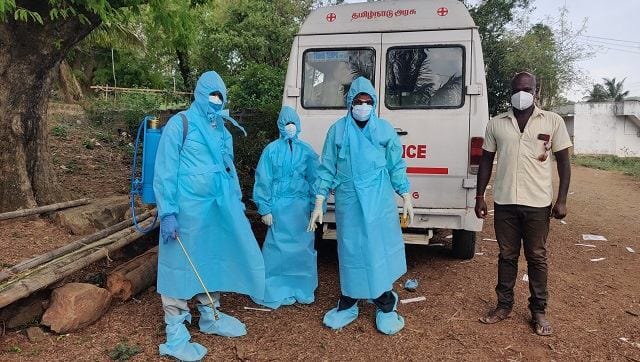 Ramesh, Nishantani, Gopi and Gurushankar at Mel Kandikal. Firstpost/Greeshma Kuthar[/caption] [caption id=“attachment_8469821” align=“alignnone” width=“640”]
Ramesh, Nishantani, Gopi and Gurushankar at Mel Kandikal. Firstpost/Greeshma Kuthar[/caption] [caption id=“attachment_8469821” align=“alignnone” width=“640”]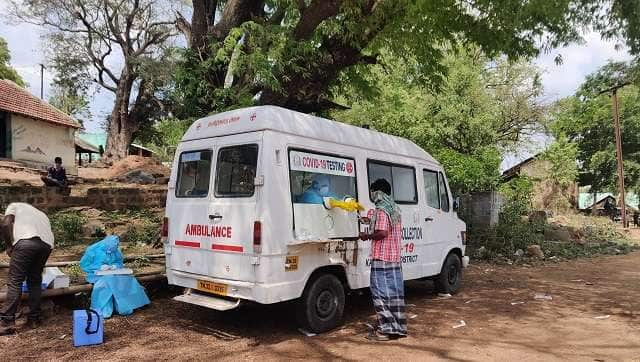 Gopi samples a resident of Mel Kandikal. Firstpost/Greeshma Kuthar[/caption] [caption id=“attachment_8469841” align=“alignnone” width=“640”]
Gopi samples a resident of Mel Kandikal. Firstpost/Greeshma Kuthar[/caption] [caption id=“attachment_8469841” align=“alignnone” width=“640”] Gopi samples a resident of Mel Kandikal. Firstpost/Greeshma Kuthar[/caption] [caption id=“attachment_8469851” align=“alignnone” width=“640”]
Gopi samples a resident of Mel Kandikal. Firstpost/Greeshma Kuthar[/caption] [caption id=“attachment_8469851” align=“alignnone” width=“640”]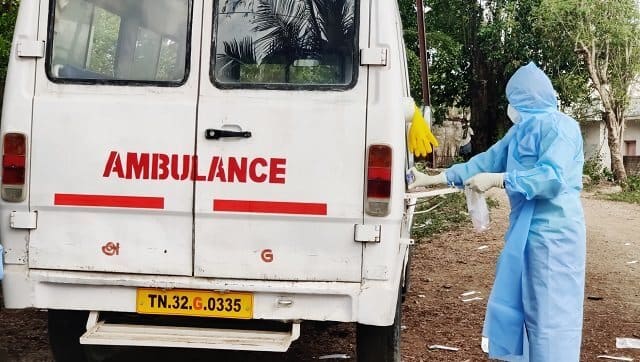 Healthcare workers collect last set of samples. Firstpost/Greeshma Kuthar[/caption] [caption id=“attachment_8469871” align=“alignnone” width=“640”]
Healthcare workers collect last set of samples. Firstpost/Greeshma Kuthar[/caption] [caption id=“attachment_8469871” align=“alignnone” width=“640”] Last set of samples being boxed. Firstpost/Greeshma Kuthar[/caption] [caption id=“attachment_8469881” align=“alignnone” width=“640”]
Last set of samples being boxed. Firstpost/Greeshma Kuthar[/caption] [caption id=“attachment_8469881” align=“alignnone” width=“640”]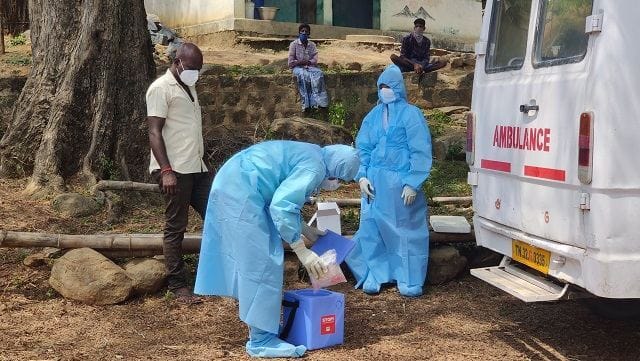 Samples being transferred to a ice box. Firstpost/Greeshma Kuthar[/caption] [caption id=“attachment_8469891” align=“alignnone” width=“640”]
Samples being transferred to a ice box. Firstpost/Greeshma Kuthar[/caption] [caption id=“attachment_8469891” align=“alignnone” width=“640”]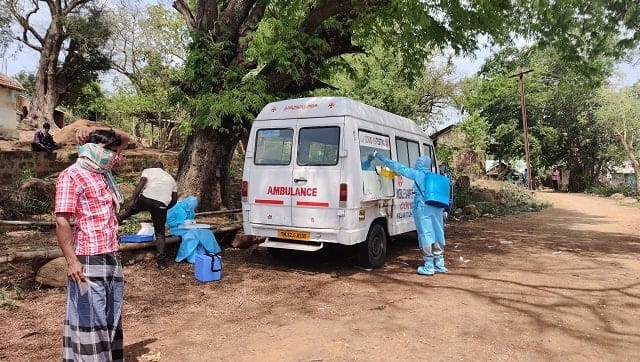 Ramesh fumigates the unit. Firstpost/Greeshma Kuthar[/caption] [caption id=“attachment_8469911” align=“alignnone” width=“640”]
Ramesh fumigates the unit. Firstpost/Greeshma Kuthar[/caption] [caption id=“attachment_8469911” align=“alignnone” width=“640”]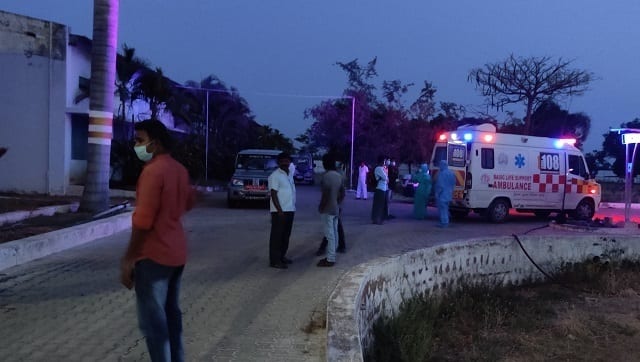 Unit reaches Mahabharathi Quarnatine Facility. Firstpost/Greeshma Kuthar[/caption] At Mel Kandikal, a four person team was collecting swabs from plantation workers who had returned from Kerala. Gopi, the LT who is leading the swab collection, has more than ten years of experience. For his colleague Nishantani, however this is the first day as a LT. What a time to start off! The process is slow, and requires patience. Each individual as they approach the kiosk is shown what to do. Since this is new for the ones who are giving their sample, some are nervous and fearful. They seem shaky and it is on Gopi and Nishantani to reassure each of them, even if just by gestures. It seems to work. Each swab takes a couple of minutes, and the fumigation takes a few more minutes. After half a day, the unit has finished sampling all new returnees to Mel Kandikal. As they prepare to head to the next village, they step out of the unit for a sip of water.
Unit reaches Mahabharathi Quarnatine Facility. Firstpost/Greeshma Kuthar[/caption] At Mel Kandikal, a four person team was collecting swabs from plantation workers who had returned from Kerala. Gopi, the LT who is leading the swab collection, has more than ten years of experience. For his colleague Nishantani, however this is the first day as a LT. What a time to start off! The process is slow, and requires patience. Each individual as they approach the kiosk is shown what to do. Since this is new for the ones who are giving their sample, some are nervous and fearful. They seem shaky and it is on Gopi and Nishantani to reassure each of them, even if just by gestures. It seems to work. Each swab takes a couple of minutes, and the fumigation takes a few more minutes. After half a day, the unit has finished sampling all new returnees to Mel Kandikal. As they prepare to head to the next village, they step out of the unit for a sip of water.
Ramesh, who is in charge of the fumigation, talks about how family life is no longer a thing for all of them. Same is the case with Gurushankar, the unit pilot. “We’ve been keeping our distance since work started in March. Now that the work is piling up, we don’t have time either. We don’t have time to long for these moments anymore,” he says.
While Nishantani still seems to be reeling from her first day experience, Gopi brushes away questions about fear of exposure. “That is the case with everybody. What can we do about that?,” he says. But he does point to his PPE and says, “Since we are at high risk, our PPE should be fully zipped, not open like this.” They are wearing wrap-around PPE’s, which they say are better than what they got initially, but can be better. So can the work hours, says Gopi with a smile, as he heads back into the unit.
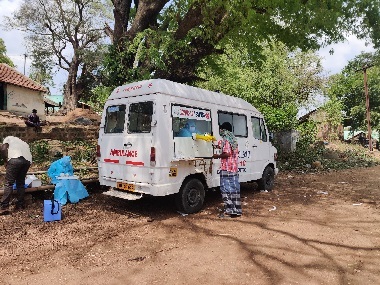)